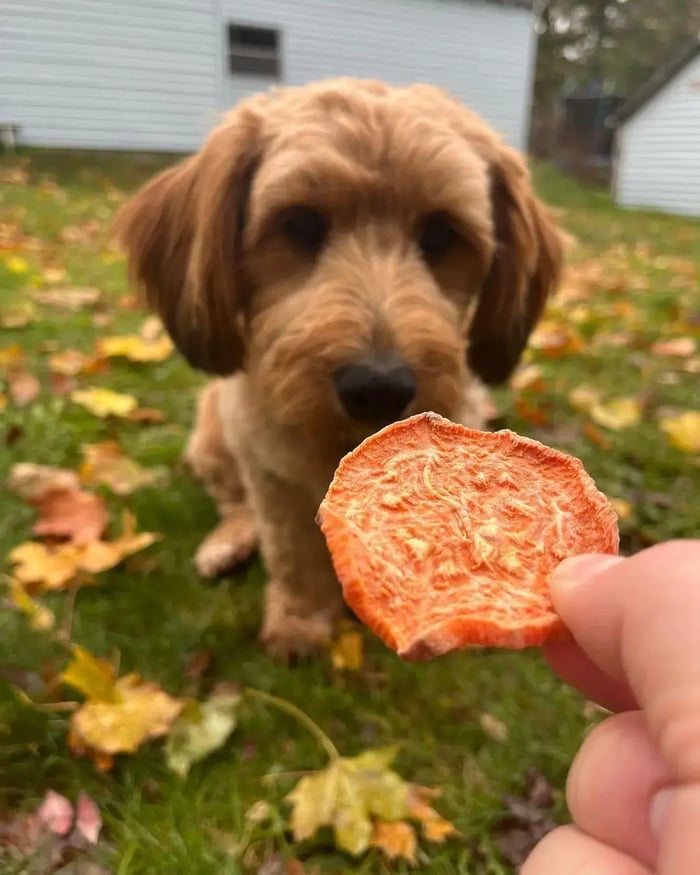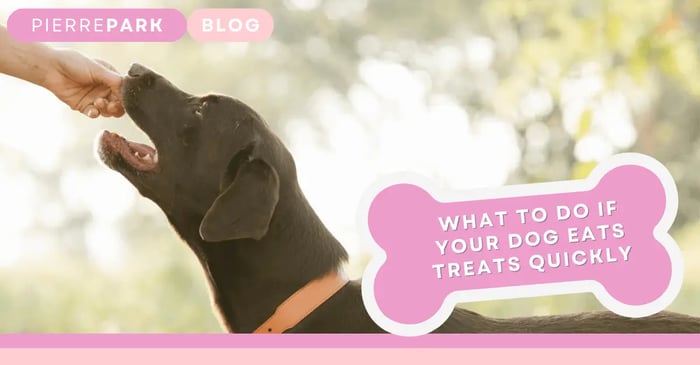Vet-Approved

This article has been rigorously reviewed and validated by Dr. Annina Müller, med. vet., an accomplished veterinarian who earned her veterinary degree at the University of Bern, specializing in Small Animal Surgery. Her expertise ensures that the advice provided is both current and accurate in the field of veterinary medicine.
Rapid treat consumption is a common concern among dog owners, with potential implications for canine health and well-being. This comprehensive guide examines the risks associated with fast treat eating, explores underlying causes, and provides evidence-based solutions to promote safer, more controlled treat consumption in dogs.
Spotting Signs Your Dog Eats Too Fast
While most dogs naturally eat quickly, it's crucial to distinguish between normal eating patterns and potentially harmful rapid consumption. The primary indicator is whether a dog chews treats or swallows them whole. Absence of chewing action typically signifies problematically fast eating. Owners should observe their dog's eating habits closely, noting any changes in speed or style of consumption .
Dangers When Your Dog Eats Too Fast: Health Concerns
1) Choking Hazard
The most immediate risk of rapid treat consumption is choking. This danger increases when dogs swallow treats whole, particularly with larger treats or multiple small treats given simultaneously. While choking can be life-threatening, it more commonly results in vomiting, discomfort, retching, or gagging.
Signs of choking include:
- Pawing at the mouth
- Excessive drooling
- Difficulty breathing
- Coughing or gagging sounds
- Blue-tinged gums or tongue
If you suspect your dog is choking, perform the Heimlich maneuver immediately or seek emergency veterinary care .
2) Intestinal Blockage (Ileus)
Although less common with treats, rapid consumption without proper chewing can lead to intestinal blockage, or ileus. This risk is particularly relevant for small dogs consuming large treats.
Symptoms of blockage include:
- Vomiting
- Retching or gagging
- Abdominal pain or swelling
- Loss of appetite
- Lethargy
- Constipation or difficulty defecating
If you notice these symptoms, consult your veterinarian promptly, as intestinal blockages can be serious and may require surgical intervention .
3) Gastric Dilatation-Volvulus (Bloat)
While rare with treat consumption, it's important to be aware of the potential for gastric dilatation-volvulus (GDV), commonly known as bloat. This condition occurs when the stomach rapidly fills with gas or fluid and potentially twists, constituting a medical emergency. Although more commonly associated with rapid eating from food bowls, particularly in large, deep-chested breeds, owners should be cognizant of this risk.
Symptoms of bloat include:
- Distended abdomen
- Unproductive retching
- Restlessness or pacing
- Rapid breathing
- Weakness or collapse
Bloat requires immediate veterinary attention, as it can be fatal within hours if left untreated .
Why Does My Dog Eat Too Fast? Root Causes Explained
Understanding the root causes of rapid treat eating is essential for effective intervention:
- Nutritional Deficiency
Dogs may consume treats rapidly if their regular diet is insufficient. Ensure the dog receives appropriate caloric intake for their size, age, and activity level. Treats should comprise no more than 10% of a dog's daily caloric intake. Consult with your veterinarian to determine the optimal diet and portion sizes for your dog .
- Inter-Dog Competition
In multi-dog households, competition can drive rapid treat consumption. This behavior, known as resource guarding, may extend to other items such as toys or preferred resting areas. Signs of resource guarding include:
- Growling or snapping when approached during eating
- Eating more quickly when other dogs are present
- Attempting to steal food from other dogs
Address this behavior early to prevent escalation and potential conflicts between dogs .
- Anxiety-Related Eating Behaviors
Anxiety, particularly in rescue dogs or those with inadequate socialization, can lead to rapid eating. This behavior often stems from past experiences of food scarcity or unpredictability. Signs of anxiety-related eating include:
- Gulping food without chewing
- Guarding food aggressively
- Appearing nervous or stressed during mealtimes
Working with a professional dog trainer or behaviorist can help address underlying anxiety issues.
Expert Tips to Slow Down Your Fast-Eating Dog
While modifying a dog's eating speed can be challenging, veterinary behaviorists and canine nutrition experts recommend several strategies:
- Controlled Hand Feeding
Hand-feeding treats individually is one of the most effective methods to regulate consumption speed. For larger treats, breaking them into smaller, manageable pieces can significantly reduce choking and blockage risks. This method also allows for better portion control and can strengthen the bond between owner and dog.
Technique:
- Hold the treat in your closed hand, allowing your dog to smell it.
- Slowly open your hand, saying "gentle" or "easy" as you do so.
- If your dog lunges for the treat, close your hand and start over.
- Reward calm behavior by allowing your dog to take the treat slowly.

- Utilization of Slow Feeders
For situations where a small portion of food is offered as a treat, slow feeders can be highly effective. These specially designed bowls or mats increase eating difficulty, thereby reducing associated health risks.
Types of slow feeders:
- Maze bowls: Feature intricate patterns that dogs must navigate to access food.
- Licking mats: Encourage dogs to lick treats from textured surfaces, slowing consumption.
- Puzzle feeders: Require dogs to solve simple puzzles to access treats.
- Managing Multi-Dog Households
In homes with multiple dogs, it's crucial to address dominant behavior during treat time. Implement individual feeding practices and use positive reinforcement techniques to encourage patient waiting.
Strategies:
- Feed dogs in separate rooms or crates.
- Use barriers like baby gates to create individual feeding areas.
- Teach a "wait" command and reward dogs for staying in place while others eat.
- Addressing Anxiety-Induced Rapid Eating
For dogs exhibiting anxiety-related rapid eating, establishing a consistent feeding routine is paramount. Adhere to regular schedules to reinforce food security. Slow-feeding toys filled with treats can benefit all dogs prone to rapid eating, not just those with anxiety, by promoting a more measured consumption pace.
Anxiety-reduction techniques:
- Create a calm environment during feeding times.
- Use pheromone diffusers to reduce stress.
- Consider anxiety wraps or thundershirts for particularly anxious dogs.
- Training for Impulse Control
Teaching your dog impulse control can help reduce rapid treat consumption. This involves training your dog to wait for permission before eating treats or meals.
Training steps:
- Hold a treat in your closed fist and present it to your dog.
- Wait for your dog to stop pawing or mouthing at your hand.
- When your dog backs away or sits calmly, say "yes" and offer the treat.
- Gradually increase the duration your dog must wait before receiving the treat.
6. Proper Treat Selection
Selecting appropriate treats plays a significant role in managing consumption speed and contributing to your dog's overall health. When choosing treats, consider the following options that can help address rapid eating:
- Single-Ingredient Dog Treats: These treats, made from one natural ingredient, offer nutritional benefits and can aid in controlling consumption. For example:
- Sweet potato dog treats, like those offered by PierrePark, provide a satisfying crunch and are rich in fiber and vitamins.
Benefits:
- Easy digestibility
- Nutrient-dense
- Free from artificial additives
- Allow for better portion control
Usage tips:
- Break into smaller pieces for training rewards or to extend consumption time
- Use as part of a balanced treat rotation
- Monitor intake, especially with crunchy treats, to prevent rapid consumption
- Long-lasting Chews: These treats are designed to occupy dogs for extended periods, naturally slowing consumption.
Examples:
- Bully sticks
- Dental chews
- Himalayan yak cheese chews
Benefits:
- Promote prolonged chewing
- Can aid in dental health
- Provide mental stimulation
- Interactive Treat-Dispensing Toys: These tools combine treats with problem-solving activities, effectively slowing down consumption.
Examples:
- Kong toys
- Puzzle feeders
- Snuffle mats
Benefits:
- Slow down eating pace
- Provide mental stimulation
- Can alleviate boredom and anxiety
When incorporating these treat types into your dog's routine, remember to:
- Introduce new treats gradually
- Supervise treat time to ensure safe consumption
- Adjust regular meal portions to account for treat calories
- Consult with your veterinarian about the best treat options for your dog's specific needs
By thoughtfully selecting and using a variety of these treat types, you can promote healthier eating habits while still providing enjoyable snacks for your canine companion.
- Regular Veterinary Check-ups
Scheduling regular veterinary visits is crucial for monitoring your dog's overall health and addressing any underlying issues that may contribute to rapid eating.
What to discuss with your vet:
- Your dog's current diet and treat regimen
- Any changes in eating habits or behavior
- Dental health, as dental issues can affect eating speed
- Potential underlying medical conditions that may influence eating behavior
Conclusion
Rapid treat consumption in dogs is a multifaceted issue with potential health implications. By understanding the underlying causes and implementing evidence-based strategies, dog owners can significantly reduce associated risks and promote healthier eating habits. Remember that each dog is unique, and what works for one may not work for another. Patience, consistency, and positive reinforcement are key to successfully modifying your dog's treat-eating behavior.
Regular veterinary check-ups and consultations with canine nutrition experts are recommended for personalized advice and ongoing monitoring of a dog's eating behaviors. By taking a proactive approach to your dog's treat consumption habits, you can ensure a healthier, happier life for your canine companion.






